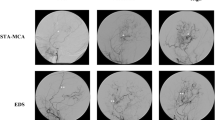Summary
Surgical results of paediatric patients with Moyamoya disease who were treated by indirect revascularization procedures are reported. Encephalo-duro-arterio-synangiosis (EDAS), encephalomyo-arterio-synangiosis (EMAS), and/or encephalo-myo-synangiosis (EMS) were performed on 47 sides of 29 children with Moyamoya disease. The results of those non-anastomotic EC-IC bypass procedures were evaluated clinically, angiographically, and by computed tomography (CT). Postoperative external carotid angiograms showed a good collateral formation through EDAS, EMAS, or EMS in about 70–80 percent of all surgically treated sides. The symptoms such as TIA, RIND, and/or involuntary movements disappeared in the cases with a good collateral formation but not in those with insufficient development of the collateral circulation. The indirect EC-IC bypass surgery seems effective for most of the children with Moyamoya disease who present with ischaemic signs.
Similar content being viewed by others
References
The EC/IC Bypass Study Group (1985) The international cooperative study of extracranial/intracranial arterial anastomoses (EC/IC bypass study): methodology and entry characteristics. Stroke 16: 397–405
The EC/IC Bypass Study Group (1985) Failure of extracranialintracranial arterial bypass to reduce the risk of ischemic stroke: results of an international randomized trial. N Engl J Med 313: 1191–1200
Fukui M, Matsushima T, Kuwabara Y, Ichiya Y, Wada M, Hasuo K (1987) Hemodynamic evaluation of moyamoya disease in children by positron emission computed tomography before and after neurosurgical procedures (EDAS, EMS, EMAS). In: Handa H (ed) Annual report of 1986 on the cooperative study of occlusion of the circle of Willis to the Ministry of Health and Welfare, pp 91–98 (in Japanese)
Ishii R (1986) Surgical treatments for moyamoya disease. Neurol Surg 14: 1059–1068 (in Japanese)
Karasawa J, Kikuchi H, Furuse S, Sakaki T, Yoshida Y, Ohnishi H, Taki W (1977) A surgical treatment of “Moyamoya” disease—“Encephalo-myo-synangiosis”. Neurol Med Chir 17 (Part 1): 29–37
Karasawa J (1978) Studies on the surgical treatment of “moyamoya” disease. J Nara Med Ass 29: 375–397 (in Japanese)
Karasawa J, Kikuchi H, Furuse S, Kawamura J, Sakaki T (1978) Treatment of moyamoya disease with STA-MCA anastomosis. J Neurosurg 49: 679–688
Karasawa J, Kikuchi H, Kawamura J, Sakai T (1980) Intracranial transplantation of the omentum for cerebrovascular moyamoya disease: A two-year follow-up study. Surg Neurol 14: 444–49
Kobayashi K, Takeuchi S, Tsuchida T, Ito J (1981) Encephalomyo-synangiosis (EMS) in moyamoya disease-with special reference to postoperative angiography. Neurol Med Chir 21: 1229–1238 (in Japanese)
Krayenbühl HA (1975) The moyamoya syndrome and neurosurgeon. Surg Neurol 4: 353–360
Kurokawa T, Tomita S, Chin E, Kitamura K, Matsushima T, Hasuo K (1985) Prognosis of children with moyamoya disease. In: Handa H (ed) Annual report of 1984 on the cooperative study of occlusion of the circle of Willis to the Ministry of Health and Welfare, pp 48–51 (in Japanese)
Kurokawa T, Tomita S, Ueda K, Narazaki O, Hanai T, Hasuo K, Matsushima T, Kitamura K (1985) Prognosis of occlusive disease of the circle of Willis (Moyamoya disease) in children. Pediatr Neurol 1: 274–277
Kuwabara Y (1986) Evaluation of regional cerebral circulation and metabolism in moyamoya disease using positron emission computed tomography. Jpn J Nucl Med 23: 1381–1402 (in Japanese)
Matsushima Y, Fukai N, Tanaka K, Tsuruoka S, Aoyagi M, Inaba Y (1980) A new operative method for “Moya-moya” disease: a presentation of a case who underwent encephalo-duroarterio(STA)-synangiosis. Nerv Syst Children 5: 249–255 (in Japanese)
Matsushima Y, Fukai N, Tanaka K, Tsuruoka S, Inaba Y, Aoyagi M, Ohno K (1981) A new surgical treatment of moyamoya disease in children: a preliminary report. Surg Neurol 15: 313–320
Matsushima Y, Aoyagi M, Fukai N, Tanaka K, Tsuruoka S, Inaba Y (1982) Angiographic demonstration of cerebral revascularization after encephalo-duro-arterio-synangiosis (EDAS) performed on pediatric moyamoya patients. Bull Tokyo Med Dent Univ 29: 7–17
Matsushima Y, Yamaguchi T, Takasato Y, Tomida S, Fukumoto T, Suzuki R, Tomita H, Inaba Y (1986) Changes in symptoms after encephalo-duro-arterio-synangiosis (EDAS) in pediatric moyamoya disease. No To Hattatsu 18: 3–7 (in Japanese)
Miyamoto S, Kikuchi H, Karasawa J, Nagata I, Yamazoe N, Akiyama Y (1988) Pitfalls in the surgical treatment of moyamoya disease, Operative techniques for refractory cases. J Neurosurg 68: 537–543
Nakagawa Y, Gotoh S, Shimoyama M, Ohtsuka K, Mabuchi S, Sawamura Y, Abe H, Tsuru M (1983) Reconstructive operation for moyamoya disease-Surgical indication for the hemorrhagic type and preferable operative methods. Neurol Med Chir 23: 464–470 (in Japanese)
Okuno T, Hatsutori H, Mikawa H, Yonekawa Y, Handa H (1984) Prognosis of “Moyamoya disease”. In: Handa H (ed) Annual report of 1983 on the cooperative study of occlusion of the circle of Willis to the Ministry of Health and Welfare, pp 46–55
Olds MV, Griebel RW, Hoffman HJ, Craven M, Chuang S, Schutz H (1987) The surgical treatment of childhood moyamoya disease. J Neurosurg 66: 675–680
Takeuchi S, Tsuchida T, Kobayashi K, Fukuda M, Ishii R, Tanaka R, Ito J (1983) Treatment of moyamoya disease by temporal muscle graft “Encephalo-myo-synangiosis”. Child's Brain 10: 1–15
Umezu R (1983) Clinical manifestations and angiographic findings of occlusive disease of the circle of Willis in children. Acta Paediatrica Japonica 87: 770–786 (in Japanese)
Yoshii Y (1977) Follow-up study of the “moyamoya”. Brain and Nerve 29: 421–424 (in Japanese)
Author information
Authors and Affiliations
Rights and permissions
About this article
Cite this article
Matsushima, T., Fujiwara, S., Nagata, S. et al. Surgical treatment for paediatric patients with moyamoya disease by indirect revascularization procedures (EDAS, EMS, EMAS). Acta neurochir 98, 135–140 (1989). https://doi.org/10.1007/BF01407339
Issue Date:
DOI: https://doi.org/10.1007/BF01407339




